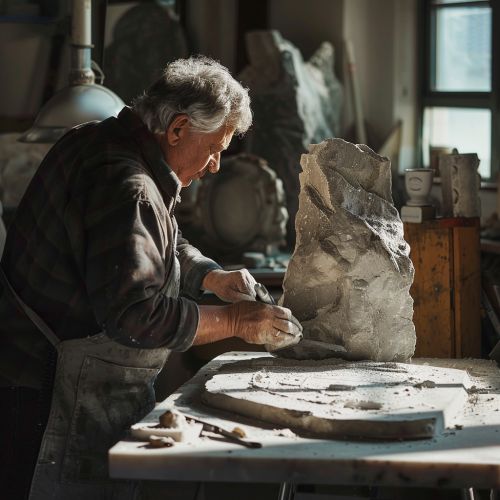Sculpture Techniques: Difference between revisions
(Created page with "== Introduction == Sculpture is one of the oldest forms of visual art, and it has been a crucial part of human culture and expression for thousands of years. The art of sculpting involves the creation of three-dimensional forms, often in the round or in high relief, using various materials and techniques. This article aims to provide a comprehensive and detailed exploration of various sculpture techniques, delving deeper than general summaries and providing...") |
No edit summary |
||
| Line 26: | Line 26: | ||
[[Forging|Forging]] involves heating metal until it is malleable and then shaping it with hammers and other tools. This technique is often used in ironwork and can produce a wide range of forms. | [[Forging|Forging]] involves heating metal until it is malleable and then shaping it with hammers and other tools. This technique is often used in ironwork and can produce a wide range of forms. | ||
[[Image:Detail-79085.jpg|thumb|center|A sculptor working on a stone sculpture in a well-lit studio.]] | |||
== Techniques == | == Techniques == | ||
Revision as of 00:37, 17 May 2024
Introduction
Sculpture is one of the oldest forms of visual art, and it has been a crucial part of human culture and expression for thousands of years. The art of sculpting involves the creation of three-dimensional forms, often in the round or in high relief, using various materials and techniques. This article aims to provide a comprehensive and detailed exploration of various sculpture techniques, delving deeper than general summaries and providing expert-level information.
Materials
Sculpture materials are diverse and have evolved over time, with artists continually seeking new methods and mediums to express their creativity. The choice of material can significantly influence the technique used and the final outcome of the artwork.
Stone
Stone is one of the oldest and most enduring materials used in sculpture. It is valued for its durability and the sense of permanence it imparts to artworks. The primary techniques used in stone sculpture are carving and assembly.
Carving
Carving involves removing material from a solid block of stone to reveal the desired form. This subtractive process requires a range of tools, including chisels, mallets, rasps, and files. The sculptor must consider the grain and hardness of the stone, which can affect the ease of carving and the finished appearance of the work.
Assembly
Assembly, or construction, involves joining multiple pieces of stone together to create a larger structure. This technique is often used in architectural sculpture and requires a strong understanding of engineering principles.
Metal
Metal is another common material in sculpture, known for its strength and malleability. The primary techniques used in metal sculpture are casting, welding, and forging.
Casting
Casting is a process where molten metal is poured into a mold and allowed to cool and solidify. This technique allows for a high level of detail and is often used for bronze sculptures.
Welding
Welding involves fusing pieces of metal together using heat. This technique is often used in contemporary sculpture, allowing for the creation of large, complex structures.
Forging
Forging involves heating metal until it is malleable and then shaping it with hammers and other tools. This technique is often used in ironwork and can produce a wide range of forms.

Techniques
The techniques used in sculpture are as varied as the materials used. They can be broadly classified into additive and subtractive techniques, as well as a combination of the two.
Additive Techniques
Additive techniques involve the addition of material to create the sculpture. This can include methods such as modeling, assemblage, and construction.
Modeling
Modeling is a technique where a soft, pliable material, such as clay or wax, is shaped and manipulated to form a sculpture. This technique allows for a high degree of flexibility and can be used to create highly detailed works.
Assemblage
Assemblage involves the combination of various disparate elements, often found objects, to create a sculpture. This technique is often used in contemporary art and can result in works that are highly conceptual or abstract.
Construction
Construction involves the assembly of various parts to create a larger structure. This technique can be used with a wide range of materials, including wood, metal, and stone.
Subtractive Techniques
Subtractive techniques involve the removal of material to reveal the sculpture. This includes methods such as carving and turning.
Carving
As mentioned earlier, carving involves the removal of material from a solid block to reveal the desired form. This technique can be used with a range of materials, including stone, wood, and even ice.
Turning
Turning is a technique where a block of material, often wood, is rotated on a lathe while tools are used to cut and shape the material. This technique can produce highly symmetrical and smooth forms.
Conclusion
Sculpture is a diverse and dynamic art form, with a wide range of techniques and materials available to the artist. From the ancient art of stone carving to the contemporary practice of assemblage, these techniques offer endless possibilities for creative expression. By understanding and mastering these techniques, artists can push the boundaries of the medium and create works that are truly unique and impactful.
